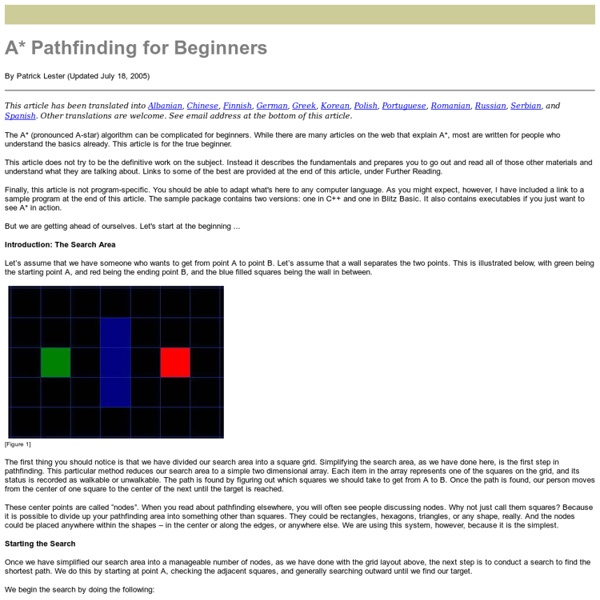Zoom
Trash
Related:



The Guide to Implementing 2D Platformers - Game Programming This article was written by Rodrigo Monteiro and originally published on his own blog at Higher-Order Fun and reprinted on our site (thanks to Rodrigo) in order to provide everyone with this great resource. Having previously been disappointed by the information available on the topic, this is my attempt at categorizing different ways to implement 2D platform games, list their strengths and weaknesses, and discuss some implementation details. The long-term goal is to make this an exhaustive and comprehensible guide to the implementation of 2D platform games. If you have any sort of feedback, correction, request, or addition – please leave it in the comments! Disclaimer: some of the information presented here comes from reverse engineering the behavior of the game, not from its code or programmers. I can think of four major ways in which a platform game can be implemented. Type #1: Tile-based (pure) Character movement is limited to tiles, so you can never stand halfway between two tiles.
Step by Step: Alpha Beta Pruning Game/AI: Fixing Pathfinding Once and For All July 26, 2008 Fixing Pathfinding Once and For All I normally do everything I can to avoid saying things that could be interpreted as a criticism of other games or developers in the industry. But in this case, I had to make a bit of an exception. I need to talk about some problems we face with pathfinding. All of these clips were recorded over the last week with the latest, most-recently-patched version of each game. As you can see, we're still a long way from having robust pathfinding across the board ... and it's even a problem in some million-unit-selling, AAA-quality titles. It's not necessarily a universal problem. But there are still too many games that do pathfinding the same way that games did in the 1990s. (Note: The only reason you see lots of PC role-playing games here just comes down to convenience. To the best of my knowledge, most of these games use waypoint graphs for pathfinding. I believe waypoint graphs are now obsolete. But we're a multi-billion-dollar industry now. 1. 2.
Math for Game Developers Video Series I've launched a new Youtube series, Math for Game Developers. Each week I'll be showing how to solve a new problem in game development using math, and I'll be building up a math toolkit that you can use to solve any game dev problem. 1. Moving a character with vectors: 2. More moving characters: 3. 4. 5. This is very basic stuff, just showing the basics of vector maths, buteventually I'll be progressing to explaining the math behind moreadvanced things. I hope to help out people who are just starting their game dev career soplease let me know if I can improve the videos (other than the lowquality audio, a problem I'm working on) or if you didn't understandsomething
A* search Understanding Pac-Man Ghost Behavior Posted on December 2, 2010 It only seems right for me to begin this blog with the topic that inspired me to start it in the first place. Not too long ago, I came across Jamey Pittman’s “Pac-Man Dossier”, which is a ridiculously-detailed explanation of the mechanics of Pac-Man. About the Game “All the computer games available at the time were of the violent type - war games and space invader types. Pac-Man is one of the most iconic video games of all time, and most people (even non-gamers) have at least a passing familiarity with it. Every level of Pac-Man uses the same maze layout, containing 240 regular “food” dots and 4 energizers. Common Elements of Ghost Behaviour “Well, there’s not much entertainment in a game of eating, so we decided to create enemies to inject a little excitement and tension. Each of the ghosts is programmed with an individual “personality”, a different algorithm it uses to determine its method of moving through the maze. The Ghost House Target Tiles Scatter Mode
N Tutorial B - Broad-Phase Collision SECTION 3: Object Grid The grid structure described above can also double as a spatial database used to manage dynamic objects. Just as each cell contains information about the tile located in that cell, it can also contain information about each dynamic object currently located in the cell. Each cell contains a list of dynamic objects; as an object moves through the grid, we insert/remove it from each cell's list as appropriate. There are two approaches that can be taken when using a grid with dynamic objects: "normal" grid: each object is associated with all of the cells it touches. . pros: each object needs to look in at most 4 cells to find other objects it might collide with . cons: each object needs to be inserted/removed from up to 4 cells every time it moves; also, additional logic needs to be added to the collision code to deal with a case where, for instance, two objects touch the same two cells. In our implementation, each cell has: and each object has: --= more details =--
Java tree data-structure